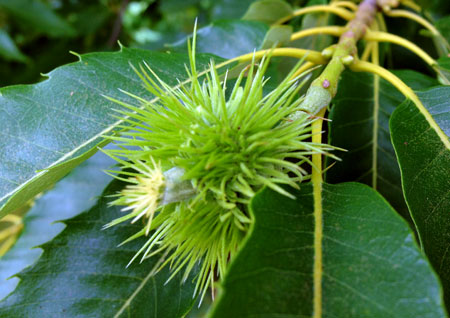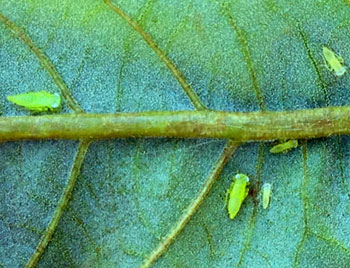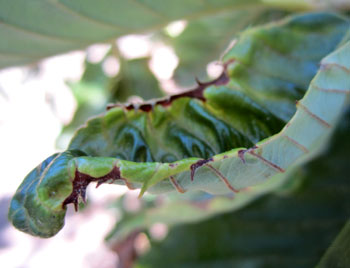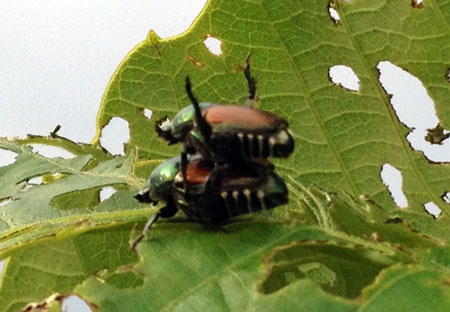Michigan chestnut update – July 26, 2013
European red mite numbers have hit treatment thresholds of seven mites per leaf in many chestnut orchards. Growers should be scouting for this potentially damaging pest and managing if necessary.
So far this season, the East Lansing Enviro-weather station has accumulated 1,536 GDD50 with 0.37 inches of rain over the past week; the Clarksville Enviro-weather station has recorded 1,447 GDD50 and 1.45 inches of rain this past week; and the Northwest Michigan Horticultural Research Center accumulated 1,331 GDD50 with 0.61 inches of rain over the last week. Small burs are forming in northwest Michigan chestnuts.

Burr formation on July 24, 2013 in northwest Michigan.
Photo credit: Erin Lizotte, MSU Extension
Potato leafhopper populations are down overall, particularly on farms where insecticide applications have been made to control the pest. All life stages of potato leafhoppers are being observed in significant numbers across the state. Like many plants, chestnuts are sensitive to the saliva of potato leafhoppers that is injected by the insect while feeding. Damage to leaf tissue can cause reduced photosynthesis which can impact production and quality, and damage the tree. Heavily damaged leaves are cupped with necrotic and chlorotic edges and eventually fall from the tree. Severely infested shoots produce small, bunched leaves with reduced photosynthetic capacity.
The most common classes of insecticides recommended for potato leafhopper control include the pyrethroids, carbamates, neonicotinoids and organophosphates. See the additional Michigan State University Extension article “Potato leafhopper management in chestnuts” for more information. Remember, even growers who believe they may have experienced crop losses due to the frost and freeze events this spring will still need to treat for potato leafhoppers to maintain tree health.


Left, Wingless potato leafhopper nymphs on the back of a chestnut leaf. Right, Symptoms of potato
leafhopper feeding. Photo credits: (Left image) Mario Mandujano, MSU, and (Right image) Erin Lizotte, MSU Extension
Japanese beetle populations are high in some areas. Japanese beetle adults are also considered a generalist pest and affect many crops found on or near grassy areas, particularly irrigated turf. Japanese beetle grubs feed on grass roots in early spring and again in the fall and can cause significant damage to turf. Larvae prefer moist soil conditions and do not survive prolonged periods of drought. Given the intense dry season Michigan experienced in 2012, we hope to see lower populations in most areas for 2013.
Adult Japanese beetles emerge in early July and feed on the top surface of leaves, skeletonizing the tissue. If populations are high, they can remove all of the green leaf material from a plant. Adults measure 0.375 to 0.5 inches long with a green thorax and copper-colored wing covers. There are five tufts of white hairs on both sides of the abdomen and a pair of tufts on the end of the abdomen that can help distinguish the Japanese beetle from other look-alike species.
Visual observation of adults or feeding damage is an effective scouting technique. Growers should scout along a transect through orchards at least weekly until detection, paying special attention to the tops of trees. Because of their aggregating behavior, they tend to be found in larger groups and are typically relatively easy to spot.

Japanese beetles mating. Chestnut leaves show typical feeding
damage. Photo credit: Mario Mandujano, MSU
There are no established treatment thresholds or data on how much Japanese beetle damage a healthy chestnut tree can sustain, but growers should consider that well-established and vigorous orchards will likely not require 100 percent protection. Carbamate (carbaryl) insecticides can provide immediate knockdown and seven days of residual activity against Japanese beetle adults. Organophosphates (Malathion and phosmet) can take longer to take effect (up to three days), but provides 10 to 14 days of residual control.
Pyrethroids (bifenthrin, beta-cyfluthrin, cyfluthrin, gamma-cyhalothrin, lambdacyhalothrin, pyrethrins, zeta-cypermethrin, deltamethrin and fenpropathrin) have good knockdown activity, and seven to 10 days of residual control, but can be a concern in orchards where mites are a problem. Pyrethroid use has been shown to flare mite populations as a result of its toxicity to beneficial predatory mites.
Neonicitinoids (imidacloprid, thiamethoxam, acetamiprid and clothianidin) act initially as a contact poison for two to five days, and then have a longer residual period of plant protection during which they have anti-feedant effects on adult beetles.
OMRI-approved organic options include neem-based products (azadirachtin) which have a one- to two-day residual and good knockdown activity as well as Surround (kaolin clay), which has had good results in blueberries and grapes and acts as a physical barrier and irritant. For more information on Japanese beetle management in chestnuts, refer to the article “Managing Japanese beetles in Chestnut for 2013.”
European red mites have reached high levels in some area orchards. European red mites overwinter in egg-form; growers can locate egg masses in crevices, rough bark, crotches usually in folds of bark inclusion, on branches and in the bud scales with the aid of a hand lens. Summer eggs are found on the leaves along the veins on both sides of the leaf, but mainly on the underside. Eggs are orange-red and resemble turbans.
After eggs hatch, nymphs move onto the young leaves and start feeding on the underside. First generation takes a bit longer to develop – about three weeks – since it has to battle cool temperatures in the early season. Summer generations, driven by the hot and dry weather, complete lifecycles in about 10 days. Under favorable weather conditions (hot and dry) they can have eight or more generations in one season. Adults are often found on the upper leaf surfaces.

Left, Early bronzing of chestnut caused by European red mite. Right, Adult European red mite
viewed under dissecting microscope. Photo credits: (Left image) Erin Lizotte, MSU Extension, and (Right image) Scott Justice
European red mite feeding damage increases as populations increase. Leaves appear mottled, stippled, and in more severe cases, bronzed. Injured leaves have reduced photosynthetic activity leading to reduced nut size, and return crop load potential as well as increased sensitivity to winter injury. Severe feeding damage can lead to early defoliation.
Orchards battling populations season-long or with high levels at the end of the year should plan to apply preventative measure to control higher overwintering populations in the spring of 2014. Dormant or delayed dormant oil applications are the most treatment timing to control mites. Summer mite management is based on monitoring or scouting procedure and use of miticides. Monitoring involves examination of 10 leaves off of 10 trees for a total of 100 leaves, randomly selected throughout the orchard. Leaves should be collected from four sides of the tree. With the help of hand lens (10X or 20X), all stages of pest and predatory mites need to be counted. Determine average mite count per leaf (total number of mites per 100 leaves).
Thresholds for treatment increase as the season progresses. At this point in the year (August-September), the leaves are larger, more mature and more tolerant to mite injury. Growers should consider treatment if they are approaching seven mites per leaf. There are a number of chestnut pesticides labeled to control mites. See the table below.
Chestnut insecticides with activity against mites
|
Chemical class (IRAC insecticide group) |
Active ingredient |
Products labeled |
|
Avermectins(6) |
Abamectin** |
Eip-mek 0.15 EC, Reaper 0.15 EC, Reaper Advance, Abacus, Abba 0.15EC, Abba Ultra, Abamectin, Agri-Mek SC, Agri-Mek S.15 |
|
METI(21A) |
Fenpyroximate |
Portal |
|
Pyridaben |
Nexter |
|
|
Pyrethroids(3) |
Bifenthrin** |
Bifenture 10DF, Bifenture EC, Brigade WSB, Fanfare 2 EC, Sniper |
|
Fenpropathrin** |
Danitol 2.4EC Spray |
|
|
Pyrethroid(3) + Pyrethroid(3) |
Bifenthrin** + Zetacypermethrin** |
Hero EW, Steed |
|
|
Bifentrhin** + Imidacloprid |
Brigadier, Swagger |
|
Tetramic acids(23) |
Spirodiclofen |
Envidor 2SC |
|
|
Potassium salts of fatty accids*1 |
M-Pede |
|
Chromobacterium subtsugae1 |
Grandevo* |
|
|
Extract of Chenopodium ambrosioide1 |
Requiem 25EC, Requiem EC |
|
|
Insect growth regulators or inhibitors |
Etoxazole |
Zeal Miticide 1 |
|
Hexythiazox(10A) |
Onager, Savey 50DF |
|
|
Azadirachtin (IGR) |
Aza-Direct*, Azatin XL, Ecozin Plus 1.2% ME*, Neemazad 1% EC*, Neemix 4.5*, Azaguard* |
|
|
Not classified or unknown |
Acequinocyl |
Kanemite 15 SC |
|
Bifenazate |
Acramite 50WS |



 Print
Print Email
Email


